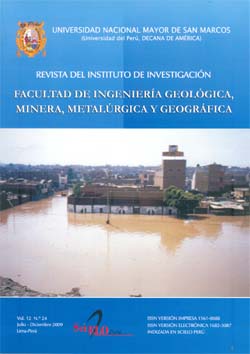Mine hard rock excavation with no blasting
DOI:
https://doi.org/10.15381/iigeo.v12i24.385Keywords:
Drilling and blasting, blasting rock breackage methods, blastless hard rock mining systemsAbstract
Drilling and blasting is generally used for fragmenting hard in situ rock in mine excavation. This method however, in addition of being expensive, it causes environmental pollution by noice, dust, vibrations and gases. It may also generate social conflicts with native communities around the mining operation as it disturbs and alters the inhabitants safety and health. Consequently, it is important to develop non drilling and blasting rock breackage methods. This can be achieved by both appropriate usage of continuous mining systems in hard rock and ingenious use of the rock tensile resistance which is ten to thirty times lower than its compressive strength. Most of the current drilling systems make use of the compressive resistance to drill and blast rock with explosives. There is no domestic experience of hard rock mining with continuos miners. The unique continuous miner adquired by an underground metallic operation no longer operates due to technical reasons. Few mine excavators for underground and superfical hard rock were developed during the last twenty years. But rock fragmentation systems with no blasting, can advance more if water and thermal energies are considered. For example water jets at high pressure, micro waves and laser beams for generating areas of tensile stress inside rock masses.
Downloads
Published
Issue
Section
License
Copyright (c) 2009 Oswaldo Ortiz Sánchez, E. Mauro Giraldo Paredes, Gudelia Canchari Silverio

This work is licensed under a Creative Commons Attribution-NonCommercial-ShareAlike 4.0 International License.
AUTHORS RETAIN THEIR RIGHTS:
a. Authors retain their trade mark rights and patent, and also on any process or procedure described in the article.
b. Authors retain their right to share, copy, distribute, perform and publicly communicate their article (eg, to place their article in an institutional repository or publish it in a book), with an acknowledgment of its initial publication in the Rev. Inst. investig. Fac. minas metal cienc. geogr.
c. Authors retain theirs right to make a subsequent publication of their work, to use the article or any part thereof (eg a compilation of his papers, lecture notes, thesis, or a book), always indicating the source of publication (the originator of the work, journal, volume, number and date).






